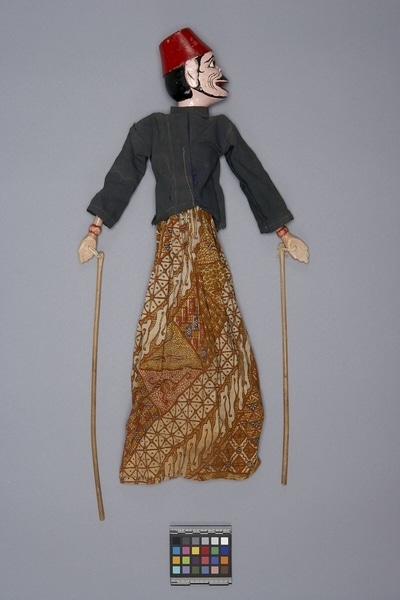Rod Puppet Item Number: Ib278 a-c from the MOA: University of British Columbia


Description
Male body (part a) composed of carved wood and fabrics; body unpainted and somewhat plain. Articulate arms jointed at the elbow and wrist are supported by sticks attached at the hand. Arm bracers, painted red, decorate the figure's wrists. Monkey-shaped face (part b) coloured pink; hair black under a red fez-shaped hat. The puppet wears a black long sleeved jacket which is soiled; a brown batiked skirt is wrapped about its waist and secured. Pointed controlling rod (part c).
History Of Use
Javanese puppetry as an art form probably developed by the 11th century. The three-dimensional wooden wayang golek puppets of western Java, which are to be distinguished from the earlier and more sacred wayang kulit shadow plays puppets or other forms, appeared during the 16th century. Originally the plays depicted Javanese mythology, but after the Indian conquest of Java the Hindu epics, Ramayana and Mahabharata, were incorporated into the cycles, which comprise about 200 plays. An individual or group hires a dalang (puppet-master) to celebrate important occasions. The performances often last all night and are generally presented in three acts, with vocal and instrumental accompaniment. The individual plays vary widely in detail but usually involve conflict between good and evil. They serve a moral and religious purpose, and more recently, one of political commentary. Each puppet's character is represented by its appearance and placement onstage; protagonists with strong elements of good are placed to the right, antagonists of violent or evil nature to the left. Togog, servant of the evil antagonists, appears in all cycles. In some tales he is considered the brother of Shiva and Sewar.
Iconographic Meaning
The puppet has several features which identify it as the evil character Togog: the monkey-shaped face is most evident, but others, such as his dress and hat, are also useful indicators.
Cultural Context
Theatrical performance.
Item History
- Made in Java, Indonesia
- Owned by Tradewind Antiques before March 15, 1983
- Received from Museum of Anthropology Shop Volunteers (Funding source) and Tradewind Antiques (Seller) on March 15, 1983
What
Who
- Culture
- Sundanese
- Previous Owner
- Tradewind Antiques
- Received from
- Museum of Anthropology Shop Volunteers (Funding source) and Tradewind Antiques (Seller)
Where
- Holding Institution
- MOA: University of British Columbia
- Made in
- Java, Indonesia
When
- Ownership Date
- before March 15, 1983
- Acquisition Date
- on March 15, 1983
Other
- Condition
- good
- Accession Number
- 0886/0012 a-c